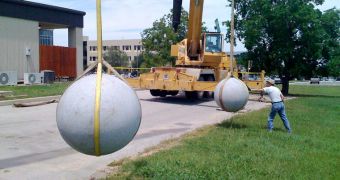Asteroid impacts helped shape the way the solar system, and indeed our planet, look today, and yet these phenomena are not that well understood. Experts are now moving away from computer models, and are taking studies of such collisions into construction yards.
Such a study involved suspending two ball-shaped boulders from 40-foot cranes, dangling them for a bit, and then smashing them into each other. This type of hands-on experience can oftentimes provide more insight into the phenomena being studied than the most precise supercomputer simulations.
The new investigation was prompted by a researcher's need to determine what happens to the debris that an asteroid collision causes while impacting a large body. In order to clear up this mystery, he hired two cranes and brought them to his research institute.
The yard of the Boulder, Colorado-based non-profit organization Southwest Research Institute (SwRI) therefore became the testing grounds for scientist Dan Durda's experiments, Space reports.
“As those rocky bits and pieces jostle themselves back together under their weak and feeble gravity, there come certain assumptions,” the expert reveals, adding that one of those is the coefficient of restitution.
The concept refers to the ratio between the speeds these ejected objects have before and after they are impacted by an asteroid. Durda decided to call in the cranes while trying to formulate this equation.
Until now, this constant had only been determined for small particle impacts, and researchers just assumed that it would remain unchanged for large, solid objects as well. As such, most simulations on this issue used extrapolated numbers. But the SwRI expert wanted to be certain.
“We decided that the best way to do this was just to go do the large-scale experiment,” he explains, adding that the group purchased two large granite spheres for this very purpose. Two cranes and their operators were also involved in the work.
As a side note, Durda says that the crane operators provided such valuable suggestions about how to conduct the experiment that they wound up being cited as co-authors in the new research paper. The work appears in the January issue of the esteemed journal Icarus.
The team carried out 108 collisions between the two spheres, of which 66 provided usable data. The study revealed a coefficient of restitution of 0.83, for the two, 2,700-pound (1,300-kilogram), 1-meter-wide rocks.
The new coefficient is more than half again that which is used in current computer models. Further work – using imperfect rocks – will help refine that number even further.
SwRI researchers are now shooting aluminum spheres the size of golf balls into the boulders, investigating the impacts in more detail. They are using a 50 mm tank gun for the job.
“At one point, I was seriously considering using an Abrams tank,” Durda says,

 14 DAY TRIAL //
14 DAY TRIAL //